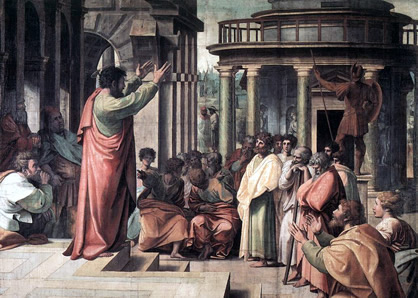Smyrna (Izmir) Rev. 1:11;2:8
The second city of the seven churches of Book of Revelation to
receive the message from the St. John was that of Smyrna.
Established as a Roman commercial center, the city was a port
located on the Aegean. Smyrna was established thirty-five miles
north of Ephesus on the road that lead to Pergamum. It was built
near the ruins of a Greek colony destroyed by the Lydian Kingdom in
the C7 BCE. Following the death of Alexander the Great, a General of
Alexanders army named Lysimachus took over the region, and
established the new Hellenistic city (C3 BCE).

The port was a natural one, and had the distinctive fortune of the
Hermus River which flowed from inland to this natural gulf. Because
of the river access to inland along with the major north-south
highway the city grew to importance. The well watered region
produced significant crops, and this provided the backbone of a
prosperous trade between land and sea
The city was reputed to be the most faithful ally of Rome according
to Cicero, as the city had a history of siding squarely with Rome.
In the conflicts of Rome and Seleucia of 195 BCE, and the war
between Mithridates and Rome the city showed true loyalty, and
received significant patronage from the Emperors in exchange.
The city was noted by the geographer Strabo for its beautiful public
buildings:
Next one comes to another gulf, on which is the old Smyrna, twenty
stadia distant from the
 present
Smyrna. After Smyrna had been razed by the Lydians, its inhabitants
continued for about four hundred years to live in villages. Then
they were reassemble into a city by Antigonus, and afterwards by
Lysimachus, and their city is now the most beautiful of all; a part
of it is on a mountain and walled, but the greater part of it is in
the plain near the harbor and near the Metroum and near the
gymnasium. The division into streets is exceptionally good, in
straight lines as far as possible; and the streets are paved with
stone; and there are large quadrangular porticoes, with both lower
and upper stories.
present
Smyrna. After Smyrna had been razed by the Lydians, its inhabitants
continued for about four hundred years to live in villages. Then
they were reassemble into a city by Antigonus, and afterwards by
Lysimachus, and their city is now the most beautiful of all; a part
of it is on a mountain and walled, but the greater part of it is in
the plain near the harbor and near the Metroum and near the
gymnasium. The division into streets is exceptionally good, in
straight lines as far as possible; and the streets are paved with
stone; and there are large quadrangular porticoes, with both lower
and upper stories.
There is also a library; and the Homereium, a quadrangular portico
containing a shrine and wooden statue of Homer; for the Smyrnaeans
also lay especial claim to the poet; and indeed a bronze coin of
theirs is called Homereium. The river Meles flows near the walls;
and, in addition to the rest of the citys equipment, there is also
a harbor that can be closed. But there is one error, not a small
one, in the work of the engineers, that when they paved the streets
they did not give them underground drainage; instead, filth covers
the surface, and particularly during rains, when the cast-off filth
is discharged upon the streets.
It was here that Dolabella captured by seige, and slew, Trebonius,
one of the men who treacherously murdered the deified Caesar; and he
set free many parts of the city. (Strabo 14.1.37) and its roads
were commended for their geometric design. With a stadium that
likely seated as many as 20,000 people, and a well developed
infrastructure, scholars believe the city grew to about 100,000 by
the time of the St. Paul and St. John. Tacitus records the city had
requested and gained permission to build a Neokorite Temple (to the
Emperor Tiberius) in the following record:
The deputies from Smyrna, on the other hand, after retracing the
antiquity of their town-whether founded by Tantalus, the seed of
Jove; by Theseus, also of celestial stock; or by one of the
Amazons-passed on to the arguments in which they rested most
confidence: their good offices towards the Roman people, to whom
they had sent their naval force to aid not merely in foreign wars
but in those with which we had to cope in Italy, while they had also
been the first to erect a temple to the City of Rome, at a period
(the consulate of Marcus Porcius) when the Roman fortunes stood high
indeed, but had not yet mounted to their zenith, as the Punic
capital was yet standing and the kings were still powerful in Asia.
At the same time, Sulla was called to witness that with his army in
most critical position through the inclement winter and scarcity of
clothing, the news had only to be announced at a public
 meeting
Smyrna, and the whole of the bystanders stripped the garments from
their bodies and sent them to our legions. The Fathers accordingly,
when their opinion was taken, gave Smyrna the preference. (Tacitus,
Annals 4.56).
meeting
Smyrna, and the whole of the bystanders stripped the garments from
their bodies and sent them to our legions. The Fathers accordingly,
when their opinion was taken, gave Smyrna the preference. (Tacitus,
Annals 4.56).
The Church of St. Polycarp reminds the modern visitor that Polycarp,
an Apostolic Father and student of the St. John, was martyred in the
city in 155 CE. His famous speech concerning his dedication to Jesus
is recalled here.
The site has little excavation, as this important commercial port
city is the second largest population in the modern Republic of
Turkey. Because of the Christian community, the city carried the
appendage infidel Smyrna for some time
.
Biblical Sites in Turkey List


